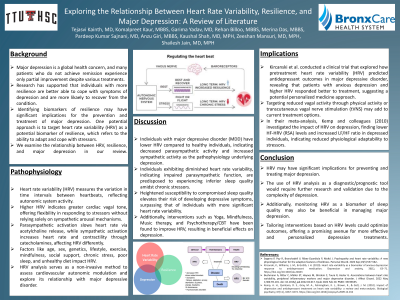Cardiology
Session: Poster Session
(008) Exploring the Relationship Between Heart Rate Variability, Resilience, and Major Depression: A Review of Literature

Trainee Involvement: Yes
.jpeg.jpg)
Tejasvi Kainth, MD
PGY1 Resident Physician
BronxCare Health System
New York City, New York, United States- KK
Komalpreet Kaur, M.B.B.S
Licensed physician in India
Baba Farid University of health and sciences
Loma linda, California, United States 
Rehan Billoo, MBBS, MD
Extern, Volunteer, Research Assistant
Family Medicine Associates of Northridge, St. Jude's Children Research Hospital, International Psychiatry Scholars Collaboration
Granada Hills, California, United States- MD
Merina Das, MBBS
Licensed Physician in India
Veer Surendra Sai Institute of Medical Science and Research
Ellicott city, Maryland, United States 
Pardeep Kumar Sajnani, MD
PGY1 Resident Physician
Larkin Community Hospital
Karachi, Sindh, Pakistan- AG
Anzu Giri, MBBS
Medical graduate
Dhaka University
Ann arbor, Michigan, United States - KS
Kaushal Shah, MD, MPH
Resident Physician
Wake Forest Baptist University
Winston Salem, North Carolina, United States - ZM
Zeeshan Mansuri, MD, MPH
PGY-6, Child and Adolescent Emergency Psychiatry Fellow
Boston Children’s Hospital/Harvard Medical School
Boston, Massachusetts, United States
Presenting Author(s)
Co-Author(s)
Background: Major depression is a global health concern, and many patients who do not achieve remission experience only partial improvement despite various treatments. Research has supported that individuals with more resilience are better able to cope with symptoms of depression and are more likely to recover from the condition. Identifying biomarkers of resilience may have significant implications for the prevention and treatment of major depression. One potential approach is to target heart rate variability (HRV) as a potential biomarker of resilience, which refers to the ability to adapt and cope with stressors. We examine the relationship between HRV, resilience, and major depression in our review.
Discussion: Individuals with major depressive disorder (MDD) have lower HRV compared to healthy individuals, indicating decreased parasympathetic activity and increased sympathetic activity as the pathophysiology underlying depression. While HRV does not improve with successful treatment, decreased HRV is believed to be a trait marker of depression. Targeting reduced vagal activity through physical activity or transcutaneous vagal nerve stimulation (tVNS) may add to current treatment options. Additionally, interventions such as Yoga, Mindfulness, Music therapy, and Psychotherapy/CBT have been found to improve HRV, resulting in beneficial effects on depression. HRV is associated with sleep quality, and individuals with lower HRV are more likely to report poorer sleep quality, leading to greater depressive symptoms. Therefore, HRV may be a useful biomarker to monitor the effectiveness of interventions on sleep quality in patients with major depression.
Conclusion: HRV may have significant implications for preventing and treating major depression. The use of HRV analysis as a diagnostic/prognostic tool would require further research and validation due to the complexity of depression. Additionally, monitoring HRV as a biomarker of sleep quality may also be beneficial in managing major depression.
References:
Segarra P, Poy R, Branchadell V, Ribes-Guardiola P, Moltó J. Psychopathy and heart rate variability: A new physiological marker for the adaptive features of boldness. Personal Disord. 2022 Sep;13(5):557-562. doi: 10.1037/per0000573. Epub 2022 May 5. PMID: 35511573.
Buchmann A, Ritter C, Müller ST, Haynes M, Ghisleni C, Tuura R, Hasler G. Associations between heart rate variability, peripheral inflammatory markers and major depressive disorder. J Affect Disord. 2022 May 1;304:93-101. doi: 10.1016/j.jad.2022.02.017. Epub 2022 Feb 20. PMID: 35196535.

